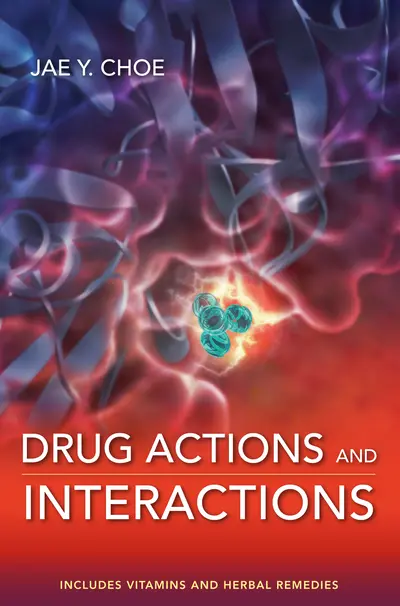My Account Details

ISBN10: 0071634754 | ISBN13: 9780071634755

Step 1 . Download Adobe Digital Editions to your PC or Mac desktop/laptop.
Step 2. Register and authorize your Adobe ID (optional). To access your eBook on multiple devices, first create an Adobe ID at account.adobe.com. Then, open Adobe Digital Editions, go to the Help menu, and select "Authorize Computer" to link your Adobe ID.
Step 3. Open Your eBook. Use Adobe Digital Editions to open the file. If the eBook doesn’t open, contact customer service for assistance.
Publisher's Note: Products purchased from Third Party sellers are not guaranteed by the publisher for quality, authenticity, or access to any online entitlements included with the product. The quick reference guide you need to avoid harmful interactions between prescription drugs, over-the-counter medications, and dietary supplements 4 STAR DOODY'S REVIEW! "This will serve as an invaluable guide for various medical professionals and basic scientists, as well as pharmacology students with an interest in understanding the relevance of drug interactions to pharmacotherapy....The book is extremely useful as a quick yet thorough guide through the wealth of information that exists for the most common drug therapies....this [book] is unique in its careful consideration of the relevance of dietary supplements to the discussion of drug interactions."--Doody's Review Service Drug Actions and Interactions is a handy easy-to-access guide to understanding what major drugs are available for specific diseases, how selected drugs produce therapeutic benefits, side effects that may occur when taking these drugs, and which drugs and supplements should not be taken in combination with each other. Applying the 300 most often prescribed drugs in the United States to more than 80 common disorders, Drug Actions and Interactions discusses each drug’s mechanism of action, side effects, and interactions with other drugs. Molecular structures of medications are also included to help you understand their mechanisms of action. Coverage includes drugs that act on the major systems (cardiovascular, respiratory, gastrointestinal, genitourinary, endocrine, neuronal); bone, muscle, skin, and joints; and general health. You will also find an appendix listing major drugs currently in use in each therapeutic classification. Thirty-two additional appendices detail interaction between a therapeutic group of drugs and an individual drug or group of drugs, such as interactions of beta-blockers, alpha-blockers, calcium-blockers, etc.
About the Author
Preface
Acknowledgements
Common Abbreviations Used in This Book
Introduction
Part I. Drugs Acting on the Cardiovascular System
1. Hypertension
2. Edema
3. Congestive Heart Failure
4. Cardiac Arrhythmia
5. Angina Pectoris
6. Thrombosis/Myocardial Infarction
7. Hemorrhage
8. Anemia
9. Varicose Veins
10. Hyperlipidemia
Part II. Drugs Acting on the Respiratory System
11. Rhinitis /Sinusitis
12. Laryngitis/Bronchitis
13. Hiccups
14. Tussis (Common Cough)
15. Asthma
Part III. Drugs Acting on the Gastrointestinal System
16. Xerostomia (Dry Mouth)
17. Aphthous Ulcer (Canker Sore)
18. Odontalgia (Toothache)
19. Gingivitis (Gum Infections)
20. Nausea/Vomiting
21. Flatulence
22. Peptic Ulcer
23. Gastroesophageal Reflux Disease (GERD)
24. Dyspepsia
25. Irritable Bowel Syndrome
26. Intestinal Cramps
27. Constipation
28. Diarrhea
29. Hemorrhoids
Part IV. Drugs Acting on the Genitourinary System
30. Erectile Dysfunction (Impotence)
31. Condylomata (Genital Warts)
32. Benign Prostate Hypertrophy
33. Urinary Incontinence
34. Nephrolithiasis (Kidney Stone)
35. Cystitis /Urethritis
36. Urinary Retention
Part V. Drugs Acting on the Bones, Muscles, and Joints
37. Osteoporosis
38. Osteoarthritis/Osteoarthrosis
39. Gout
40. Myasthenia Gravis
41. Muscle Spasticity
42. Carpal Tunnel Syndrome
43. Rosacea
44. Eczema
45. Psoriasis
Part VI. Drugs Acting on the Neuronal System
46. Stress/Anxiety
47. Seasonal Affective Disorder
48. Attention Deficit Hyperactivity Disorder
49. Chronic Fatigue Syndrome
50. Mental Depression
51. Mania
52. Psychosis
53. Alzheimer Disease
54. Memory Impairment
55. Epilepsy
56. Parkinson Disease
57. Vertigo
58. Motion-Sickness
59. Multiple Sclerosis
Part VII. Drugs Acting on the Endocrine System
60. Diabetes Mellitus
61. Diabetes Insipidus
62. Addison Disease
63. Cushing Disease
64. Hyperthyroidism
65. Hypothyroidism
66. Hypogonadism/Infertility
67. Menstrual Dysfunction
68. Menopausal Symptoms
69. Breast Engorgement
70. Hyperemesis Gravidarum
Part VIII. Drugs Acting on General Health
71. Algesia (Physical Pain))
72. Pyrexia (Fever)
73. Insomnia
74. Pregnancy
75: Allergic Reactions
76. Obesity
77. Cancers
78. Systemic Infections by Viruses
79. Systemic Infections by Bacteria
80. Systemic Infections by Fungi
81. Malaria
82. Dysentery
83. Helminthiasis
84. Chemical Poisoning
Appendixes
Appendix A: Major Drugs in Therapeutic Classifications
Appendix B-1: Interactions of Beta-Blockers
Appendix B-2: Interactions of Alpha-Blockers
Appendix B-3: Interactions of ACE Inhibitors
Appendix B-4: Interactions of Thiazide Diuretics
Appendix B-5: Interactions of Loop Diuretics
Appendix B-6: Interactions of Angiotensin-Receptor Blockers
Appendix B-7: Interactions of Calcium Channel-Blockers
Appendix B-8: Interactions of Alpha-Agonists
Appendix B-9: Interactions of Protease Inhibitors
Appendix B-10: Interactions of Antihistamines, First-Generation
Appendix B-11: Interactions of: Antihistamines, Second- Generation
Appendix B-12: Interactions of Atypical Antipsychotic Drugs
Appendix B-13: Interactions of Macrolide Antibiotics
Appendix B-14: Interactions of Antifungal Drugs
Appendix B-15: Interactions of Belladonna Alkaloids
Appendix B-16: Interactions of Benzodiazepines
Appendix B-17: Interactions of Cephalosporins
Appendix B-18: Interactions of Gastric Antacids
Appendix B-19: Interactions of Magnesium Salts
Appendix B-20: Interactions of Glucocorticoids
Appendix B-21: Interactions of H-
Need support? We're here to help - Get real-world support and resources every step of the way.